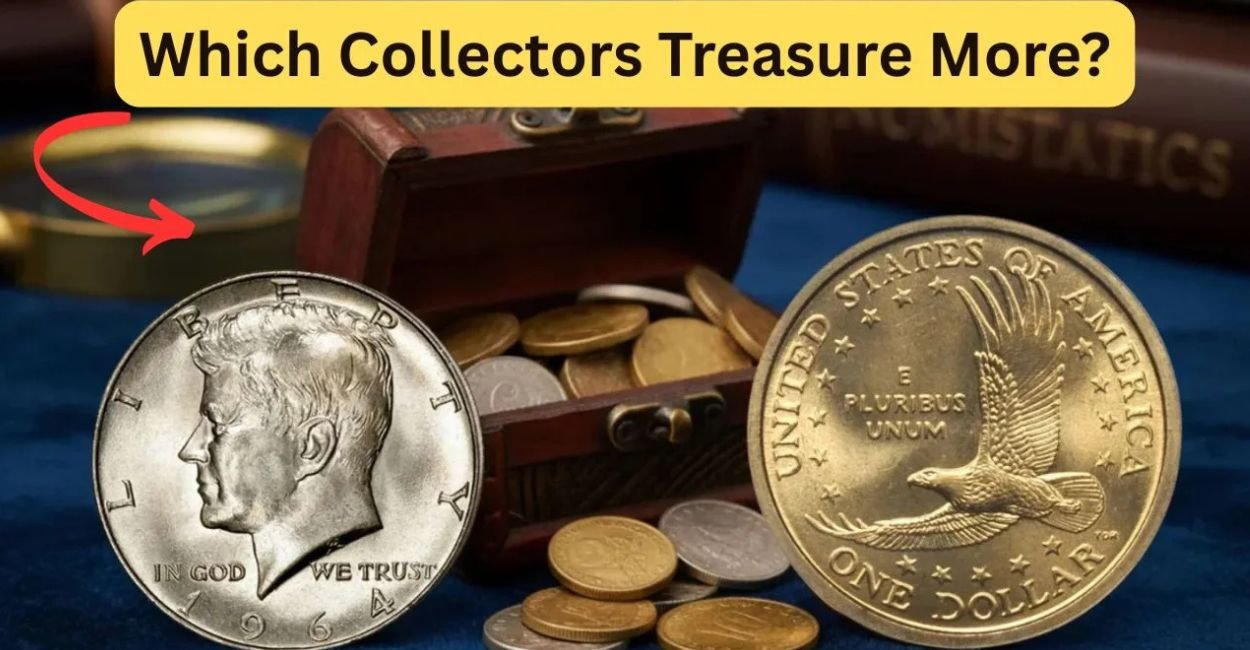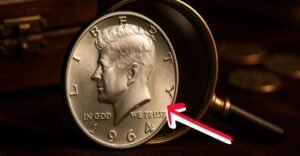Ever flipped through a coin jar and pulled out a shiny half dollar or a golden dollar that sparked curiosity? In the world of U.S. numismatics— that’s the fancy term for coin collecting—two standouts battle for top spot: the Kennedy Half Dollar and the Sacagawea Dollar. The Kennedy honors a beloved president with a touch of silver history, while the Sacagawea celebrates a trailblazing Native American woman with a modern golden glow. But which one truly captures the imagination of collectors today?
The Backstory: How the Kennedy Half Dollar Came to Be
Picture the shock of 1963: President John F. Kennedy’s sudden loss gripped the nation. Just months later, in 1964, the U.S. Mint unveiled the Kennedy Half Dollar as a heartfelt tribute. This 50-cent coin was the first to feature a real U.S. president on a circulating piece since the early 1900s. Folks hoarded them like keepsakes, turning what should have been everyday change into instant heirlooms.
Over the decades, it stuck around, with tweaks to keep it fresh. By the 1970s, rising metal costs led to a switch from pricey silver to cheaper alloys, but the design stayed true to Kennedy’s legacy. Today, it’s minted mostly for collectors and special sets, rarely jingling in vending machines. Its emotional pull? Unmatched— a symbol of hope cut short, making every piece feel personal.
A Quick Look at Its Lasting Legacy
From family albums to auction floors, the Kennedy Half Dollar evokes the 1960s’ spirit. Silver versions from day one still whisper stories of unity, drawing in buyers who value history over just the shine.
Unveiling the Sacagawea Dollar: A Golden Guide to Adventure
Fast-forward to 2000: The Susan B. Anthony Dollar flopped in popularity, so the Mint needed a fresh face for the one-dollar coin. Enter the Sacagawea Dollar, named after the Shoshone woman who guided explorers Lewis and Clark across uncharted lands in 1804-1806. With her baby son on her back, she became a beacon of strength and exploration—perfect for a new millennium.
This coin aimed to spark dollar use in daily life, but like its predecessor, it mostly ended up in jars and collections. Its golden color (from a special metal mix, not real gold) and changing back designs—highlighting Native American events—keep it exciting. Special editions, like one rolled out with breakfast cereal boxes, add rarity that thrills hunters.
Why It Shines in Modern Collections
The Sacagawea Dollar stands for diversity and grit, flipping the script on who gets celebrated on money. Its evolving artwork makes it a series to build, not just a single score.
Design Breakdown: Faces and Tales on Each Coin
Designs tell tales—the Kennedy Half Dollar keeps it classic. Front: A sharp left-facing profile of JFK, with “Liberty” and the year framing him. Back: The presidential shield, arrows, and olive branch, screaming strength and peace. It’s bold, presidential, and frozen in time.
The Sacagawea flips the vibe. Obverse: Sacagawea gazing right, cradling her child—pure warmth and resolve. Reverse: Starts with an eagle soaring, then shifts yearly to spotlight Native crafts, like woven baskets or peace medals. This yearly refresh? A collector’s dream, keeping things dynamic.
Spotting the Differences at a Glance
One’s a somber nod to leadership; the other’s a vibrant homage to guidance. Both pack emotion, but Kennedy feels like a monument, Sacagawea like a journey.
Metal Makeup and Minting Magic: What They’re Made Of
Early Kennedys (1964-1970) boasted 90% silver with 10% copper— that’s why they’re heavy and valuable beyond face worth. Post-1970? A copper-nickel sandwich over pure copper core, lighter and cheaper for mass making. Minted in Philadelphia (no mark), Denver (“D”), and San Francisco (“S”), billions exist, but silver ones are the gems.
Sacagawea Dollars? No bling here— a brass-like blend of 88.5% copper, 6% zinc, 3.5% manganese, and 2% nickel for that eye-catching gold tone. Struck since 2000 at the same mints, they’re tough for circulation but shine in proofs. Special runs, like the 2000 “Cheerios” promo, used unique tools for eagle backs, spiking rarity.
Everyday vs. Heirloom: How Materials Affect Use
Kennedy’s silver roots make it a metal investor’s pick; Sacagawea’s alloy suits modern pockets but steals shows in themed sets.
Worth the Hunt: Values and Rare Finds Compared
Cash value? It swings wild. A common Kennedy from the 1980s might snag $1-2 circulated, but that 1964 silver proof? Up to $50 or more mint-fresh. Errors like doubled dies or missing marks push prices to $500+. Hoarding keeps them out of change, so finding one feels like winning.
Sacagawea basics hover at $1-3, but rarities explode: The 2000 Cheerios edition with its feathered eagle reverse? $5,000-$10,000 easy. Yearly Native themes add flavor, with low-mint proofs fetching $20-100. No silver premium, but cultural ties build steady demand.
Head-to-Head Value Snapshot
Check this table for a quick 2025 market peek (estimates for good condition; pros grade for exacts):
| Feature | Kennedy Half Dollar | Sacagawea Dollar |
|---|---|---|
| Base Circulated Value | $0.50-$2 (post-1970) | $1-$2 |
| Premium Rare Example | 1964 Silver Proof: $20-$50 | 2000 Cheerios: $5,000+ |
| Top Auction Record | $25,000 (error varieties) | $10,000 (promo editions) |
| Key Rarity Driver | Silver content & early years | Special reverses & low mintage |
| Investor Appeal | High (metal melt value) | Medium (thematic series) |
Kennedy edges in raw bucks; Sacagawea wins on story swaps.
Collector Buzz: Which Coin Grabs More Fans?
Kennedy fans? Endless—they’re the gateway drug for hobbyists, blending nostalgia with easy finds. Silver hunts at banks or estate sales fuel the fire, and sets fill albums fast. It’s broad appeal: History buffs, investors, even casual savers.
Sacagawea pulls a dedicated crowd: Folks into women’s history, Native stories, or modern mint flair. The yearly backs encourage “type sets,” where you chase themes like liberty or wildlife. Less mainstream, but passionate—online forums buzz with promo hunts.
The Ultimate Showdown: Sentiment vs. Innovation
Kennedy tugs heartstrings with presidential weight; Sacagawea inspires with fresh faces. In polls and sales, Kennedy leads for sheer volume, but Sacagawea grows among diverse collectors seeking underrepresented tales.
Conclusion: Pick Your Piece of History—Kennedy or Sacagawea?
In the ring of U.S. coins, the Kennedy Half Dollar and Sacagawea Dollar each claim a corner: One a silver-lined salute to a fallen leader, the other a golden thread weaving Native resilience into the American tapestry. From 1964’s somber start to 2000’s bold refresh, they’ve evolved beyond pockets into prized possessions. Kennedy might top charts for emotional heft and melt-down worth, but Sacagawea steals hearts with its forward gaze and creative twists.
Which reigns supreme? That’s your call—history’s depth or innovation’s spark. Dust off your change, snag a loupe, and start collecting. In 2025’s market, both promise stories worth more than face value. Who knows? Your next find could tip the scales.
Frequently Asked Questions (FAQ)
What’s the main difference in value between Kennedy Half Dollars and Sacagawea Dollars?
Kennedy’s early silver ones pack metal worth, hitting $20+ easily, while Sacagawea relies on rare designs like the Cheerios promo for $5,000 boosts—condition always counts.
Does the Sacagawea Dollar contain real gold?
No, it’s a clever alloy mix giving a gold look—no actual precious metal, just durable brass-like shine for everyday (or collector) use.
Why are Kennedy Half Dollars hard to find in change?
Hoarding kicked off in 1964 for their tribute vibe and silver, plus the Mint shifted to sets over circulation—now they’re more album stars than store buys.
Which coin is better for beginner collectors: Kennedy or Sacagawea?
Kennedy for easy history hunts and silver thrills; Sacagawea if you love themes and modern variety—both under $5 to start, building passion step by step.
Can errors boost a coin’s price for either type?
Absolutely—doubled dates on Kennedys or unique backs on Sacagaweas can multiply value 10x or more; always check with a grading service like PCGS for the win.




